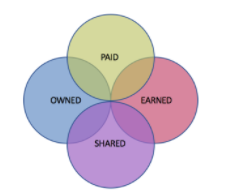What are the key strategies that startup founders can follow in order to best establish their brand and to tell their story to the most important audiences in the right channels? In this guest blog, 1871 mentor and PR expert Kellee Johnson from Ballast Group gives us her take.

Guest Co-Author: Rebecca Somers, Ballast Group

Young generations today are increasingly foregoing the traditional path of finding a secure job with an established company and are instead gravitating toward joining the exciting and sometimes volatile world of startups.
I, for one, could not be happier.
Twelve years ago, the same year that Steve Jobs gave his famous commencement speech to Stanford University, giving graduates the advice to “Stay hungry. Stay foolish,” I founded the Ballast Group. This was after working for big companies like Tropicana and Abbott Labs as well as several tech and medical startups. I decided it was time to satisfy my curiosity and passion for connecting the dots by starting an integrated communications firm. And I have loved every minute of it since – staying hungry by always learning and staying foolish by not being afraid to make a mistake by taking risks.
As a firm focused on healthcare and technology clients, the Ballast Group helps companies gain a spot on the map as they establish a name for themselves against the competition and solve problems others didn’t know (or want to admit) they had. I have learned that there are a few key strategies that startup founders can follow in order to best establish their brand and to tell their story to the most important audiences in the channels that matter.
The “Why”

First and foremost is to determine your “why.” When you decide to start a company, you need to consider how you will establish your brand by the visual, the voice and the values – all part of the journey in telling your company’s story. As you grow, build a few storylines that communicate your mission to your target audiences and reinforce your ‘why.’
Third-Party Stakeholders
The next step is to identify stakeholders who can speak on behalf of your “why.” These third parties carry credibility so that a company does not have to always talk about itself. Find those customers, politicians, academics, news media and other influencers who care about your company, services or product and build relationships with them. Your audiences are more likely to begin to trust your brand when others find it relevant and valuable.
The Channels that Matter

The last step is to find the channels that matter to your most important audiences. Today, companies communicate through various channels at once. Knowing how to identify and mix paid, earned, shared and owned media opportunities is the magic formula. Read about your industry. See what others in your space are doing. Where do your stakeholders consume their information? What do they care most about? Armed with these answers you can develop a geo- and demographic-targeted plan to reach your objectives.
These three strategies have proven to be particularly important for startups that the Ballast Group has worked with through client relationships, philanthropic activity, academics and mentoring.
Several years ago, we worked with an anonymous at-home testing kit for a huge public health problem -- sexually transmitted diseases. In order to raise awareness about the company getSTDtested.com and its mission, we focused on the “why” being the large number of people diagnosed with STDs each year. To support our “why” we put together a national expert health panel at a college to discuss the issues. The use of these stakeholders offered independent credibility to the company and helped it acquire front-page coverage in the Wall Street Journal’s Health Journal and on NBC5 Chicago where the story was picked up nationally by NBC affiliates resulting in awareness and online orders in 32 states.
Once a story is published the real work begins. We then shared it in different communication channels to further reach the company’s audiences, including new customers, partners and investors. Now this fully-funded startup is a self-sustainable company and part of the PinPointCare family of companies.
Defining a “why,” finding third-party stakeholders and using the appropriate channels, helps entrepreneurial founders develop and communicate their story and gain exposure with the right audiences at the right time.
As an entrepreneur, you may not be a communication pro, but taking these strategic steps can help tell your story and move you one step closer to getting your company’s name on the map for additional funding, awareness and lead generation.
Are you an 1871 member? Schedule one-on-one mentoring with Kellee Johnson from the Ballast Group on the 1871 Mentor Portal.
Learn more about becoming an 1871 member here.
The opinions expressed here by 1871 guest writers are their own, not those of 1871.


